RENEGADE GARDENER™
The lone voice of horticultural reason
The 2007 Renegade Gardener High Spot / Black Spot Awards
1-03-08 – New Year’s greetings and a gracious good evening to all in attendance, both here in the audience and to those joining tonight’s broadcast via the Internet. Live, from VFW Post 1791 in Chaska, Minnesota, it’s the 8th Annual Renegade Gardener High Spot/Black Spot Awards!
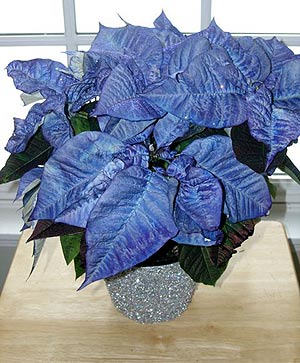 |
| Oh, don’t worry. |
A bit of housekeeping before we begin dispensing the awards … first, my heartfelt thanks to World War II veteran and Post 1791 bartender, Vernon Gustafson, for once again dusting off his bagpipes and leading us all, just moments ago, in that hair-raising rendition of “The Star Spangled Banner,” as he has done so graciously for each of the past seven award ceremonies. I think we would all agree, he gets a little better every year.
Second, when it comes to ordering drinks at the bar this evening, remember: screwdriver, rum and coke, bloody Mary, rye and ginger, scotch on the rocks. Order anything fancier than that, you’ll discover Vernon don’t hear so good.
Let’s give out the first award!
High Spot Award
Feng Shui Gardening Principles Rejected in China
Taipei, China resident Lo Pu-yi, an expert on feng shui (in case you just woke up from a ten-year coma, it’s the ancient Chinese practice of placing objects so that they are in harmony with the environment) felt that the mass plantings of bamboo, banyan trees, and willows planted near his home by the city as a part of an urban improvement project were, in his words, “putting my life at risk.”
One night, Lo took it upon himself to cut down 40 of the plants. For his actions, a Taipei District Court sentenced him to four months in jail and fined him $12,000 in damages. (As reported in the Christian Science Monitor)
 Black Spot Award
Black Spot Award
“Simple” Becomes “Super Simple”
Garden industry marketing experts intent on dumbing-down gardening to new lows have, in at least one instance, abandoned the practice of describing a gardening product or task as “simple” and adopted the apparently clearer and less angst-inducing phrase, “Super Simple,” as noted in the ad snippet here.
Black Spot Award
Citizens Complain Landscape Restoration “An Eyesore”
Open minded, tree-hugging euphorians appear to be in short supply in St. Croix Falls, Wisconsin.
After the city paid for the installation of prairie landscaping around the new St. Croix National Scenic Riverway Headquarters & Visitor Center, citizens flooded the August 13 City Council meeting to complain that the prairie landscaping was an eyesore. To quote councilman Darrell Anderson, “People are just having a fit with the weeds growing around the thing.” One anonymous letter writer wanted to know, “what the abandoned building was down by the dam.”
A public education program about the timelines for establishing a native prairie, and what native prairie can look like, has stemmed somewhat the tide of angry residents. Riverway biologist Robin Maercklein admitted “It’s a bit of a mess right now, there’s no question about it,” but added, “Actually, it looks better this year than I would have expected.” Ranger Dale Cox said native vegetation planted a few years ago at the Riverway visitor center in Trego drew the same initial reaction, but, “Nobody up there complains anymore,” now that people understand the principles behind it, and the planting looks better entering its fourth season. (As reported in the Osceola, Wisconsin Sun)
High Spot Award
Perennial of the Year: Baptisia ‘Purple Smoke’
Pronunciation: bap-TIZZ-ee-ah
Common Name: False Indigo, or, in the south, “Redneck Lupine,” which I just love.
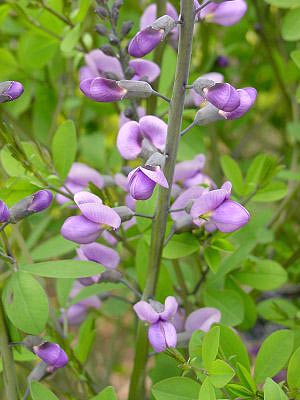 |
| Baptisia ‘Purple Smoke’ |
One of the first perennials I grew was Baptisia australis, a most unusual looking, tough-as-nails perennial that’s native from Pennsylvania to Indiana and south to Georgia and Tennessee. I’ve divided it several times over the years—no small feat, as plants develop a taproot so deep and tough one could tether a dirigible to it—and all divisions plus the original plant still thrive in my zone 4 garden after twenty-two years.
Credit for this utterly magnificent, newer (1996) variety goes to Rob Gardner, propagation curator at the North Carolina Botanical Garden. He noticed that bee-induced sexual shenanigans had occurred between native Baptisia australis (which features deep blue flowers) and the white-flowering native B. alba. The resulting variety, ‘Purple Smoke,’ retains the charcoal stems of the latter and the bluish-green leaves of the former. The big payoff, however, is the splendid flower color, best described as dusty purple or smoky violet, take your pick.
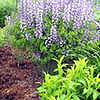 ‘Purple Smoke’ is as vigorous and tough a perennial as you’ll find, a plant that even I have no problem describing as “low maintenance.” Born of native roots, the plant prefers soil on the dry side once established. It rarely needs fertilization and plays well with cruddy, poor soil. About the only consideration necessary to its health is that flowering is discouraged in acidic soils—a pH to 7.0 or slightly alkaline is preferred. It is the only plant on my naturally acidic property that receives a bit of lime around the outskirts every couple of seasons.
‘Purple Smoke’ is as vigorous and tough a perennial as you’ll find, a plant that even I have no problem describing as “low maintenance.” Born of native roots, the plant prefers soil on the dry side once established. It rarely needs fertilization and plays well with cruddy, poor soil. About the only consideration necessary to its health is that flowering is discouraged in acidic soils—a pH to 7.0 or slightly alkaline is preferred. It is the only plant on my naturally acidic property that receives a bit of lime around the outskirts every couple of seasons.
You are rewarded in spring and early summer with mass waves of glorious flowers in great abundance. The unique foliage is a strong visual component to your garden’s season-long tapestry. What I love most is that all baptisia develop after four years or so into virtual perennial shrubs during the growing season, ‘Smoke’ attaining heights of four feet with nearly equal girth. Patience is required; you need to give baptisia three to four seasons to show what you truly planted.
The plant thrives in full sun to part shade. Bloom in part shade/half day sun (where I grow ‘Purple Smoke’ in addition to B. australis) is not terribly compromised. Listed as hardy in USDA Zones 4-8, though I’ll bet dollars to donuts it will handle Zone 3 with winter mulch, it’s just that no one who makes these judgments has tried.
But do remember that taproot. Plant ‘Purple Smoke’ in a smart spot the first time. My three ‘Smokes’ are new this past season, so not quite ready for the camera. My thanks for the photos to contributors to the outstanding gardening website, Dave’s Garden (davesgarden.com).
If you can’t locate ‘Purple Smoke’ in pots at your local nursery, here are some fine mail order sources:
Ambergate Gardens – Chaska, MN Niche Gardens – Chapel Hill, NC
www.ambergategardens.com www.nichegardens.com
Avant Gardens – Dartmouth, MA Plant Delights Nursery – Raleigh, NC
www.avantgardensne.com www.plantdelights.com
Black Spot Award
Fine Gardening Butchers B & B Tree Planting Rules
 Fine Gardening is, in my opinion, the best all-around gardening magazine in America. So you can imagine my surprise when I encountered the article, “Planting the Right Way” and discovered that in the section concerning the planting of ball-and-burlap (B & B) trees, they had it just about all wrong.
Fine Gardening is, in my opinion, the best all-around gardening magazine in America. So you can imagine my surprise when I encountered the article, “Planting the Right Way” and discovered that in the section concerning the planting of ball-and-burlap (B & B) trees, they had it just about all wrong.
The article appears in the current issue, February 2008, but the magazine hit my mailbox in early December, thus making it eligible for these 2007 awards. Plus I wanted to—once again, and never, I fear, for the last time—attempt to nip in the bud what will no doubt continue the confusion about planting all things B & B.
On page 40, the magazine instructs readers that B & B trees should be placed in the planting hole, that the twine around the trunk and attached to the top loops of the metal cage should be removed, that these metal loops should be cut off, that the burlap on top should be cut off around the trunk—and that’s it. Leave the metal cage and all the rest of the burlap around the ball, and fill ‘er in with dirt.
No, no, no. University of Minnesota research proves conclusively that the right way (and folks, there is only one “right way”) to plant a B & B tree or shrub is to remove the metal cage and all the burlap after the plant is safely in the hole and has been straightened.
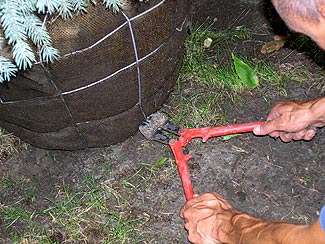 |
| Here, I’m snipping around the bottom of the cage while the tree sits beside the hole. I’ll snip up one side and remove the cage and burlap once the tree is in the hole. |
Doing it right is not that much more difficult. You just need to dig a large hole, large enough so that after the ball is in place and you’ve removed all the twine, you have room to snip the cage all around the very bottom of the plant, just above the dirt it sits on, with a short-handled wire or bolt cutter. Or snip the cage all around the bottom as it sits beside the hole (easier), then wrestle the plant in the hole. Don’t remove the entire cage prior to planting, however, or the root ball might break while you try to lift (and finally wind up rolling) a tree with a very heavy root ball into the hole.
Once in the hole, snip up one side, and you can remove the entire cage. Then with a sharp blade, cut the burlap down one side from the trunk to the bottom of the hole. Next, slice the burlap where it emerges from the bottom of the ball all the way around in a circle, and remove. If you snipped around the base prior to planting, you will be backfilling a completely bare root ball, with only a circle of burlap remaining under the very bottom.
 |
| Above: Use a pry bar to bend out the wire at the base so you can get good purchase with your bolt cutter. Below: Here’s what is discarded after planting: the entire cage and virtually all the burlap. |
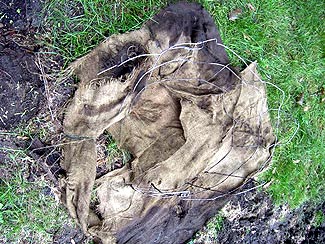 |
Well, you know me, in for a pence, in for a pound. Might as well finish up the whole tutorial. Those of you in the audience, this might be a good time to head over to the bar to refresh your cocktail. Remember: screwdriver, rum and coke…
The Fine Gardening article makes the oft-repeated, misleading claim that the burlap surrounding the root ball, “will decompose as the roots grow through it.” In fact, there will be very little decomposition of the burlap in the first growing season or seasons. A warning to those who don’t read magazines but rely solely on Internet information instead: The corresponding video tutorial on the magazine’s website repeats the ill-founded advice, with the voiceover intoning, “The burlap underground will decompose over time and won’t be a problem.”
The problem is that burlap decomposition rates vary by zone. Soil temperature and length of growing season are key factors. Burlap around a palm planted in Florida will decompose quicker than burlap around a pine planted in St. Louis. In Zones 2-5, burlap will stifle root growth for at least three to four years. How rainy the season and degree of soil drainage are additional factors that cause major variances in the rate of burlap decomposition.
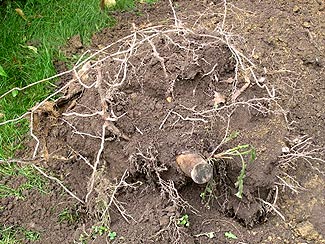 |
| Above: Cause of spruce death: Planted with the cage and burlap left on root ball. Below: Sturdy burlap on a root ball after eight to ten years in the ground, Zone 4. |
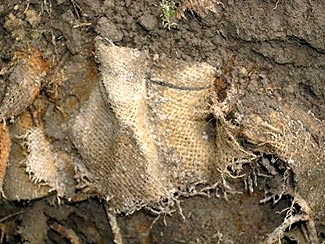 |
Not that it matters. In any zone, in the critical first full season after the tree is planted, the burlap will keep vitally important secondary and tertiary feeder roots from advancing outward into the soil. They do NOT penetrate the burlap to any great degree. The steel cage itself can also deflect and slow the growth of primary and secondary roots during the attempted life of the tree.
B & B trees and shrubs planted without removing the cage and burlap typically sit like a statue for one to four years, depending on zone, soil type, and watering rate. It’s the burlap. The tree is struggling and being stressed during its critical first season(s) in the ground.
Sometimes, they die. This summer I replaced a dead blue spruce for a client, and after ripping it out with my Bobcat discovered immediately why it had perished. A previous landscaper had planted three spruce in a row without removing the cage and burlap. One in three didn’t make it.
The two spruce that did survive were now sixteen feet high, meaning they were all planted at least eight years ago. Still in non-decomposed evidence around much of the root ball of the one that died, held in place by the cage, were healthy patches of root-foiling burlap.
The article also failed to mention that nationwide, about half the container trees purchased at nurseries have on average six inches of excess soil packed above the trunk flair, due to shoddy mechanized potting at the wholesale growing ranges. If you don’t check the tree and remove this excess soil, you are planting the tree six inches too deep, which will also stress the tree, and in some cases, lead to premature death.
But the judges subtracted no points for this omission. Only readers of University of Minnesota research reports, and this site, know that one.
High Spot Award
Best National Gardening Magazine: Fine Gardening
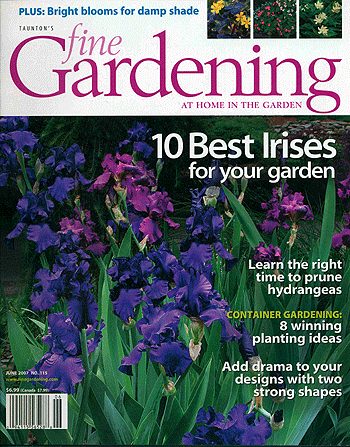 Two or three years ago—I don’t remember, I get far too many gardening magazines—this venerable purveyor of good gardening practices underwent both a striking design renovation plus jumped several notches in its capacity to relate how-to information in such ways as to inspire.
Two or three years ago—I don’t remember, I get far too many gardening magazines—this venerable purveyor of good gardening practices underwent both a striking design renovation plus jumped several notches in its capacity to relate how-to information in such ways as to inspire.
Strong on imparting the merits of foliage contrast in addition to flower color, the importance of trees and shrubs in the landscape, and a much-welcome emphasis on articles concerning the design and engineering of hardscapes, Fine Gardening enters the new year as the best national gardening magazine you can buy.
Over the past few years, the magazine’s “By gardeners, for gardeners” modus operandi has shifted to a more polished look and tone, and in this case, it’s a good thing. You still get the popular forum of tips submitted by readers, but as one delves deeper between the pages you’ll find contributors comprising a pretty impressive who’s who list of top garden writers and experts. Yet the information imparted remains useful (and coherent) to beginning and expert gardeners alike.
Whether focusing on a specific plant genus, imparting the design and engineering factors behind landscape lighting, showing what’s hip for containers, teaching readers how to prune flowering shrubs, or create great soil, first-rate writing, graphics and photography are FG’s consistent standard.
Sure, they get the facts muddled once in awhile, but what magazine doesn’t? I don’t want to confess the number of articles on this site that I have tickled and tweaked over the years, as new research unfolds, or polite readers gently prove that something I’ve written is flat-out wrong.
A one-year subscription (six issues) costs around thirty bucks, and can be had by visiting www.finegardening.com.
High Spot Award
Best Regional Gardening Magazine: Northern Gardener
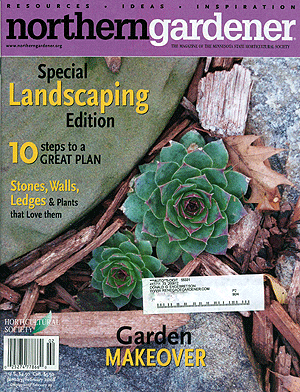 I’ll admit, neither I nor my fellow judges read them all, but of the half-dozen regional gardening magazines that did wind up in that stack over there, Northern Gardener flies above the competition.
I’ll admit, neither I nor my fellow judges read them all, but of the half-dozen regional gardening magazines that did wind up in that stack over there, Northern Gardener flies above the competition.
In magazine publishing, longevity certainly counts for something, and in the case of NG, the fact that it has been published continuously since 1871 (one-hundred and thirty-seven years!) counts for being the oldest gardening magazine in America.
Vast improvements over the past three years make NG invaluable to gardeners having at it in USDA Zones 2-5. Over the decades, the magazine has always been consistently good, but design layout upgrades, more emphasis on photographs, and bigger budgets for writers have helped the magazine achieve a solid, national magazine look, tone and feel.
 Regular feature columns such as “Northern Natives,” “Plant to Pick,” “Perennial Favorites,” “Garden Basics,” “Plant Health” and “Up North” consistently deliver great information on plants, design, garden care and techniques. The ensuing feature articles covering all aspects of gardening instruct, illuminate, and inspire.
Regular feature columns such as “Northern Natives,” “Plant to Pick,” “Perennial Favorites,” “Garden Basics,” “Plant Health” and “Up North” consistently deliver great information on plants, design, garden care and techniques. The ensuing feature articles covering all aspects of gardening instruct, illuminate, and inspire.
Sure, the cynical old coot that writes the perennial column each issue benefits greatly from stern editing, but good editing and writing is evident throughout. Published by the Minnesota State Horticulture Society, Northern Gardener doesn’t focus on Minnesota, it focuses on providing everything Zone 2-5 gardeners want and need to know. There’s a reason its subscribers include gardeners from Maine to Oregon and every Canadian province.
A one-year subscription (six issues) costs thirty-four bucks. For sixty bucks you can receive the magazine and become a member of the MSHS; membership includes many benefits. To subscribe, visit www.northerngardener.org.
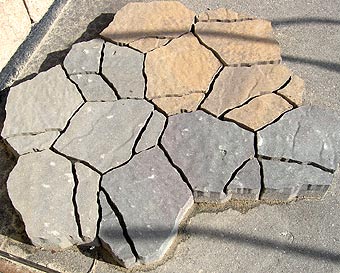 Black Spot Award
Black Spot Award
Almost the Worst Gardening Product of the Year: Concrete Flagstone
You have to admit, the concrete products industry is tenacious. And ridiculous. New on the scene in early ’07 was this product, advertised as, “matching the look of flagstone without the high material or installation costs.” Yeah, well I used to drink Blatz beer, too. You get what you pay for.
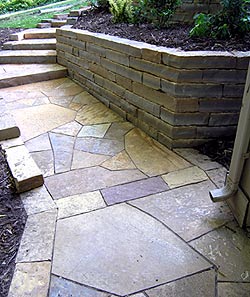 |
| Is it just me, or does stone always look better? |
In the picture what you are looking at is actually three single sections, each section containing six to nine pieces formed atop a nylon mesh. You lay your base, then fit each section together because, well, they fit. But the largest individual pieces you are looking at are no more than eight to ten inches across.
That’s tiny. Lay a patio, or even a sidewalk, using this system, and all you’ll see are the margins (cracks). It’s way out of scale. Natural flagstone comes in pieces from twelve inches to forty inches across. They can’t make the concrete pieces in this system nearly that big, because they’ll break in transit, and tear the mesh while proving difficult to lay.
Better luck next time.
High Spot Award
Proven Winners Markets Creeping Charlie
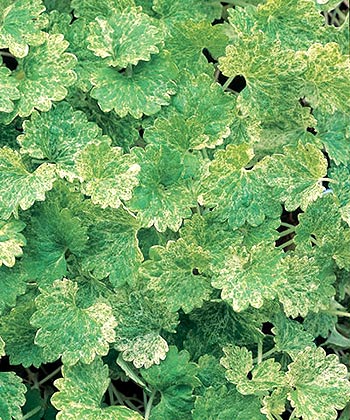 It just goes to show: You can’t make it up fast enough. Eight years ago, I wrote a joke bit on this site (“Creeping Charlie Meets Borax”) about how the commercial nursery industry blew it, that instead of allowing Creeping Charlie (Glechoma hederacea) to become banished to the noxious, invasive, undesirable weed list, they should have cultivated it years ago and brought it to market as a hot new perennial groundcover.
It just goes to show: You can’t make it up fast enough. Eight years ago, I wrote a joke bit on this site (“Creeping Charlie Meets Borax”) about how the commercial nursery industry blew it, that instead of allowing Creeping Charlie (Glechoma hederacea) to become banished to the noxious, invasive, undesirable weed list, they should have cultivated it years ago and brought it to market as a hot new perennial groundcover.
Well, the Proven Winners nursery brand just did, and my hat is off to them. Under their Proven Selections line, they now sell Glechoma hederacea ‘Dappled Light.’
As I predicted, they messed with the plants’ genes a-plenty, coming up with a non-flowering variety of Creeping Charlie featuring scalloped leaves with chartreuse tones and minty accents. It’s gorgeous. You can plant it either as a three to six-inch, spreading groundcover, or use it as a trailer in containers. Hardy to Zone 5, it grows in sun or shade, requires average moisture and never needs deadheading.
My only regret is that they steamed out the invasive gene; ‘Dappled Light’ doesn’t race from here to the doghouse and back near as quickly as the Creeping Charlie we all know and love, but still, the plant at least is now on the right side of the law.
Black Spot Award
Most Confusing Press Release Headline: “Non Toxic Weed and Grass Killer”
This is getting so easy I may have to ask the judges to desist from giving industry press releases award consideration in the future. Press releases from Pharm Solutions Inc., manufacturers of a wide variety of chemical garden products, consistently tout their non-selective herbicide product WEED PHARM as “an alternative to chemical herbicides.” Judges were particularly smitten by their use of the phrase, “non-toxic weed and grass killer.”
Such are the jukes, jumps and gyrations made by garden product marketing professionals to give the impression that “chemicals” are flat-out evil, while their cuddly, chemical-free products are pure, organic and safe for the environment.
All Renegade Gardeners are required to know that every material thing can be broken down into chemical compounds. Further, you should recognize how the organic movement has hijacked the word chemical and attached to it the strong connotation of negative qualities.
In truth, when it comes to garden fertilizers, pesticides, fungicides and herbicides, you can choose between products containing organic chemicals (chemicals derived from plants, animals, or the earth and harvested by indigenous peoples who donate half their profits to food shelves) or synthetic chemicals (chemicals created by evil white Republicans in lab coats). Either way, you are always dealing with chemicals. Your choice as a gardener is between organic chemicals or synthetic chemicals. I use both. Both have positive and negative attributes, and both, if used contrary to label directions, can be harmful to humans, plants, animals, and the environment.
As is the case with this product, this “alternative to chemical herbicides,” which, upon reading of its Material Safety and Data Sheet (required by law), informs users: “Vapors irritating to the eyes and respiratory tract. Avoid inhalation. Liquid may cause eye burns and permanent damage to cornea, possibly leading to blindness. Causes skin irritation. Avoid runoff into storm sewers and ditches that lead to waterways.Treat or dispose of waste material as a weak acid in accordance with all local, state/provincial and national requirements.”
Well, at least it’s organic.
High Spot Award
Best Gardening Product of the Year
Harmony Stone Wall System
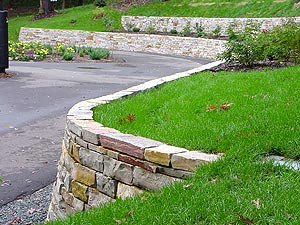 Never before in the history of the High Spot/Black Spot Awards has a product brochure been slipped into the “Black Spot” file by judges early in the season, only to wind up receiving not only a High Spot Award, but the award for Best Gardening Product of the Year.
Never before in the history of the High Spot/Black Spot Awards has a product brochure been slipped into the “Black Spot” file by judges early in the season, only to wind up receiving not only a High Spot Award, but the award for Best Gardening Product of the Year.
What you have here is a natural stone wall system in which the stone has been measured, pre-cut, and numbered, then loaded in order onto pallets so that, when delivered, homeowners can install their own stone wall without having to select, break or fit a single stone.
You can see the judges’ conundrum. I mean, just what in hell do we have here? I was prepared to stomp the product to stone dust. Is this yet another example of an advanced gardening project made “super simple” by a berserk gardening industry interested only in ripping the joy of learning, of developing an expertise, clean out of the equation?
Leave it to Fjodor Kovalenko, a retired moose hunting guide, logger, and stonemason from Flin Flon, Manitoba, and, at ninety-two, the senior judge on this year’s awards panel, to set me straight. Taking me outside so he could have a smoke during last week’s furious debate over the product, Fjodor put an arm around my shoulder, squeezed, looked me square in the eye and said, “Listen, you self-absorbed, stringy little Norwegian groot, the bottom line is, a person can buy the product and wind up building a beautiful stone wall.”
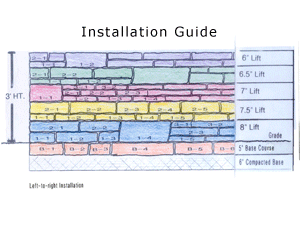 I should mention two facts about this tender exchange. First, Fjodor stands nearly six foot three (and this is after shrinking five inches since his early seventies), weighs around 225 and has hands the size of your average computer printer. Second, “groot” is a delightful Ukrainian slang term, the exact definition of which makes for uncomfortable reading.
I should mention two facts about this tender exchange. First, Fjodor stands nearly six foot three (and this is after shrinking five inches since his early seventies), weighs around 225 and has hands the size of your average computer printer. Second, “groot” is a delightful Ukrainian slang term, the exact definition of which makes for uncomfortable reading.
So I deferred to Fjodor. The wall kit comes with a colored diagram and, as mentioned, each stone is numbered on top. You still need to excavate and install a proper compacted gravel base, you still need to backfill with eight inches of clear gravel for drainage if building a wall higher than thirty inches, but once you lay the first stone, all you have to do is lift and place.
The cool thing is, the final product is a random wall, that is, there are no even courses. I’ve built walls like these, and they’re gorgeous, but while you look at the photos, begin to realize how much screwing around is involved to make the top course (or “cap course”) even. You have stone that is different heights running throughout the wall, but you need to finish at the same, uniform, level height. I charge fifty-two dollars a square foot to build a wall like this, and know some stone landscapers who charge more.
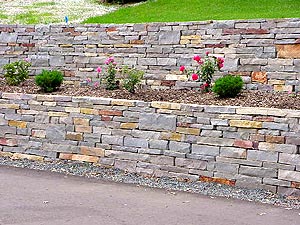 Each wall system includes different kinds of stone, so you have the color blend thing going on as well. And while the product does indeed dumb down the wall building process, Fjodor is right. Anything that is going to get homeowners to use natural stone instead of that dreadful concrete retaining wall block is a fine thing.
Each wall system includes different kinds of stone, so you have the color blend thing going on as well. And while the product does indeed dumb down the wall building process, Fjodor is right. Anything that is going to get homeowners to use natural stone instead of that dreadful concrete retaining wall block is a fine thing.
The Harmony Stone Wall System was invented and patented by the good folks at Hedberg Landscape Supply, Minnesota’s largest stone supply company, with five locations around the Twin Cities. They deliver all around the metro area. If you live in a different state or Canadian province, call Hedberg (763-545-4400), give them the wall dimension you want, and they’ll put it on a common carrier and get it to you. Even with the freight, building it yourself could be cheaper than hiring a local landscaper to build one. Building these types of walls from scratch using random wall stone is tricky. You do a lot of splitting, and finishing level on top drives you crazy. The third one of these I built looks a whole lot better than the first one. A veteran stone landscaper will build you a nice one, but another landscaper who says he knows how to do it will build you one that could wind up looking like groot.
For more information, visit Harmony Stone.
Black Spot Award
Worst Gardening Product of the Year: Painted Plants
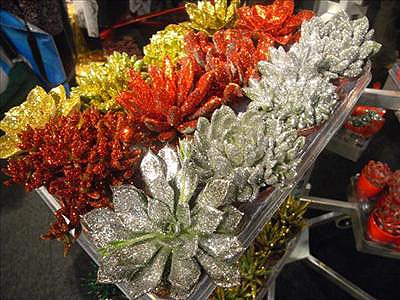 Wretched. Despicable. Revolting. Nauseating. Execrable. Repulsive. Repugnant. Disgusting. And these are just a few of the words Roget’s Thesaurus has to say about the single most heinous nursery trend in America: painted plants.
Wretched. Despicable. Revolting. Nauseating. Execrable. Repulsive. Repugnant. Disgusting. And these are just a few of the words Roget’s Thesaurus has to say about the single most heinous nursery trend in America: painted plants.
Blame the Dutch. That’s where the crazy idea started, then spread from the Netherlands across Europe, like a sickening plague. The first time I spotted a painted plant was in a greenhouse in Portland, Oregon three years ago, where on a table sat four-inch pots of a dwarf, broad-leaved grass painted silver. I though they were plastic.
This past year—and oh, baby, wait until summer 2008—painted plants hit America, and whereas “Just Say No” may have failed as a campaign slogan to keep kids off drugs, please, dear God, join with me to make the phrase the sterling steel sword that cuts off this gruesome trend at the knees.
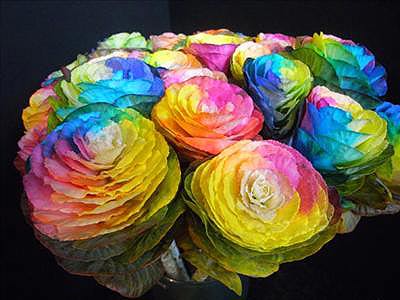 |
| Ornamental kale became all the rage in containers due to its fabulous natural leaf color. To the nursery industry, that’s apparently no longer good enough. |
In a nutshell, the nursery industry is taking perfectly lovely, healthy plants, and spray painting them, because Americans don’t use enough Day-Glo orange plants in their containers, apparently. Sometimes they sprinkle the plants with glitter, after painting. The end result is plants that appear to be made from paper, or plastic, or both. They look like cheap, painted silk flowers. Plus, the plants wither and die quicker. Why not make them from paper? Why waste perfectly good plants?
The weird thing is, I can’t find anyone who likes them. This summer, UPS began delivering them to my home, free from nurseries, because I’m a garden writer, and the nurseries apparently never visit my site. I started showing them to people, and asking their opinions.
 |
| This used to be a poinsettia. |
From Dave, my left wing, Bush-hating, Socialist neighbor: “Typical. Money-grubbing corporate big business creating demand where there is no need, by spending millions on marketing that could go to education. They’re creating a product to stir elitism and keep the proletariat class in its place.”
From Martha, my right wing, Bush-loving, Christian fanatic dentist: “Typical. Money-grubbing, left-coast hippie nurseries trying to force their liberal, LSD induced lifestyles on the rest of the country. They’re creating a product that manipulates God’s perfect creation.”
From Leo, my apolitical, atheist fishing buddy: “Man, are those ugly.”
They all have valid points.
My gosh, look at the time! This concludes the 2007 Renegade Gardener High Spot/Black Spot Awards. You are now invited outside to the VFW’s lovely back yard picnic area, where I will be roasting brats and hotdogs for all in attendance.
 |
| The Renegade Gardener discovers the only positive use for painted plants. |
Don Engebretson
The Renegade Gardener
- The 2018 Renegade Gardener High Spot/Black Spot Awards January 5, 2019
- The 2017 Renegade Gardener High Spot/Black Spot Awards January 1, 2018
- The 2016 Renegade Gardener High Spot/Black Spot Awards January 1, 2017
- The 2015 Renegade Gardener High Spot/Black Spot Awards January 1, 2016
- The 2014 Renegade Gardener High Spot/Black Spot Awards January 7, 2015
- The 2013 Renegade Gardener High Spot/Black Spot Awards January 1, 2014
- The 2012 Renegade Gardener High Spot/Black Spot Awards January 4, 2013
- The 2011 Renegade Gardener High Spot/Black Spot Awards January 1, 2012
- The 2010 Renegade Gardener High Spot/Black Spot Awards January 1, 2011
- The 2009 Renegade Gardener High Spot/Black Spot Awards January 1, 2010
- The 2008 Renegade Gardener High Spot/Black Spot Awards January 1, 2009
- The 2007 Renegade Gardener High Spot/Black Spot Awards January 3, 2008
- The 2006 Renegade Gardener High Spot/Black Spot Awards December 20, 2006
- The 2005 Renegade Gardener High Spot/Black Spot Awards December 9, 2005
- The 2004 Renegade Gardener High Spot/Black Spot Awards January 1, 2005
- The 2003 Renegade Gardener High Spot/Black Spot Awards November 19, 2003
- The 2002 Renegade Gardener High Spot/Black Spot Awards October 31, 2002
- The 2001 Renegade Gardener High Spot/Black Spot Awards October 16, 2001
- The 2000 Renegade Gardener High Spot/Black Spot Awards October 20, 2000